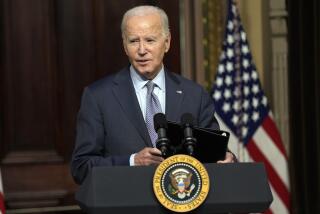A federal effort to lead ‘green’ technology
- Share via
Reporting from Washington — Half a century ago, after the Soviet Union jolted Americans by sending Sputnik into orbit, the Defense Department launched a little-noticed program designed to help the United States leapfrog the frontiers of technology by doling out millions of dollars for research on radically new ideas.
The Defense Advanced Research Projects Agency -- DARPA in Pentagonese -- backed projects that led to such military advances as the light, rapid-fire M-16 rifle and Stealth warplanes that were invisible to radar. The efforts also led to revolutionary civilian technology, such as the Internet.
Now, the same approach is being tried for energy and “green” technology. Though critics say innovation is best achieved by private-sector entrepreneurs, the Obama administration is betting an initial $400 million in government seed money on such future possibilities as giant batteries filled with molten metal and exotic materials that spin sunlight and water into methane.
Arun Majumdar, a former UC Berkeley professor and national lab assistant director who worked under DARPA funding for a decade, is the director of ARPA-E -- the Advanced Research Projects Agency-Energy created under the Energy Department -- which will showcase its program at a meeting in Washington on Monday.
“We have taken the best practices for how we operate from DARPA,” Majumdar said, including focus, collaboration and hiring practices. But unlike the military, which could buy the fruits of DARPA research technologies, ARPA-E technologies will have to compete on an existing energy market.
“In some sense,” he said, “the challenge is harder.”
Majumdar further discusses the difficulties his agency faces.
So the ultimate price of the technologies you’re pursuing is very important?
We’re much more conscious about price [than DARPA]. . . . One of the main purposes of this summit is, how do we scale innovation in the United States [so that energy technologies are manufactured domestically]? . . . Our goal is to provide those technologies that allow people to make money. That’s the best way to scale in the United States.
Is there pressure on ARPA-E to invest in projects that could show results quickly enough to affect the security, climate and economic debates we’re having today?
We need to have a balanced portfolio there. Some things we have to invest [in] which are longer-term. . . . It took 20 years or so for the Internet to scale up. . . . I wish we could say we would develop the equivalent of the Internet in two years. That would be unrealistic.
How will you know when an idea isn’t working out?
In all our projects, there are certain performance metrics -- you have to do it at a certain rate, and at a certain cost. . . . We tell our [project leaders], if you’re going to fail, fail quickly, and learn from it. And if you have a better idea, let us know. We can be flexible.
Why is it important for the government to push such innovation, instead of waiting for the market?
The next 20 years is the most important time in our nation’s history, because what we do now will affect the rest of the century.






